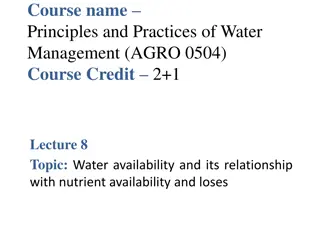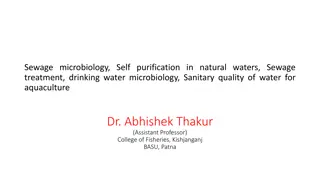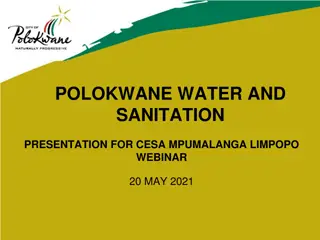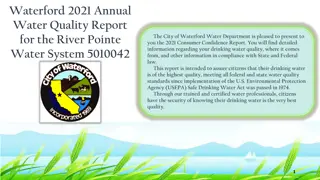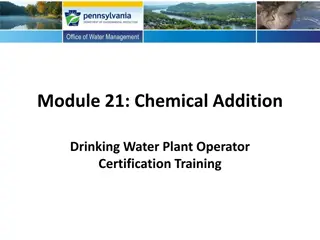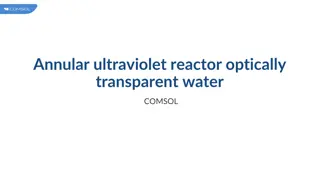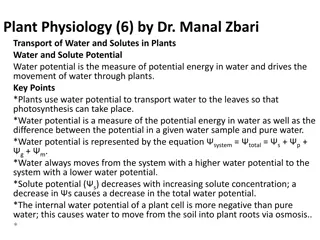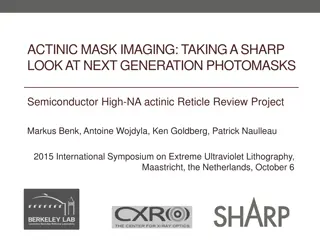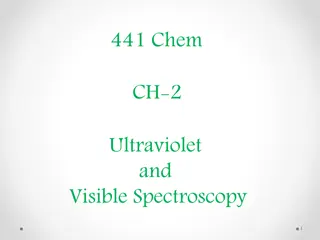Ultraviolet (UV) Water Treatment Overview
Ultraviolet (UV) water treatment is an effective and convenient method for disinfecting water by exposure to UV radiation. It is easy to use, requires minimal contact time, and has no taste or odor issues. The installation process involves low-pressure mercury lamps operating at 254 nm, protected by quartz sleeves, and requires proper sizing and maintenance. Key considerations include water quality, pre-treatment, proper installation, and monitoring for failures. Remember to follow manufacturer guidance for lamp replacement and ensure no re-contamination downstream of the unit.
Download Presentation

Please find below an Image/Link to download the presentation.
The content on the website is provided AS IS for your information and personal use only. It may not be sold, licensed, or shared on other websites without obtaining consent from the author.If you encounter any issues during the download, it is possible that the publisher has removed the file from their server.
You are allowed to download the files provided on this website for personal or commercial use, subject to the condition that they are used lawfully. All files are the property of their respective owners.
The content on the website is provided AS IS for your information and personal use only. It may not be sold, licensed, or shared on other websites without obtaining consent from the author.
E N D
Presentation Transcript
Treatment Ultraviolet (UV) Matt Bower DWQR Risk Assessment Training 2018
Overview Disinfects by exposure to UV radiation Minimal contact time Cheap, easy, no chemical handling Effective against bacteria and Cryptosporidium No taste and odours, minimal by-product formation Needs clean, low-organics water No lasting residual
Installation Usually low pressure mercury lamp operating at 254 nm, protected by quartz sleeve Units should be rated at 30-40 mJ cm-2to be effective Transmissivity of water needs to be >80% (and monitored) Unit needs to be correctly sized, installed correctly and maintained Install so that no headspace (air lock) Reliable Power supply needed
Usage Fouling can be an issue, especially if iron or manganese present. Quartz sleeve needs cleaning at appropriate frequency. DWQR Technical Note Lamp will need changing in accordance with manufacturers guidance. Some have counter. Some form of failsafe should be included in event of lamp or power failure (alarm or shutdown). No residual, so need to ensure water not re-contaminated downstream of unit. Keep spares! Plenty of guidance available see DWQR Technical Note
Key Points to Watch For Variable water quality Lack of pre-treatment Unintended bypasses / recirculation Inappropriate siting Undersizing (may need flow restrictor) Fluctuating power supply Lack of maintenance / checks
Questions Notes Code Question TUV1 Could undisinfected water pass into supply? (Has the UV system appropriate alarms or an automatic shutdown arrangement?) Where UV treatment is installed to mitigate against, for example, the risk of Cryptosporidium then the system should not be operable if the UV is not working. This may be achieved through failsafe mechanisms whereby the supply ceases if the UV stops working. If the UV treatment can be switched off, or bypassed, but water can still be delivered, there is a risk that undisinfected water may be supplied. If the system is likely to occasionally shut down, some capacity to store treated water as contingency may be required. UV disinfection will only be effective where the incoming water is adequately pre-treated to remove substances that will prevent the UV light from passing through the water. Additionally, contaminants such as iron and manganese can foul the UV lamp and reduce its effectiveness drastically. Most water supplies, unless they are high quality groundwaters, will require several stages of filtration prior to UV disinfection. TUV2 Could inadequate preliminary treatment compromise UV disinfection process? TUV3 Could low UV transmissivity / high colour compromise UV disinfection at times? Check that the water passing the UV lamp is monitored for turbidity and that turbidity readings do not exceed the acceptable range for the lamp. Ensure that turbidity remains below 1NTU prior to disinfection. Check for any evidence of sediment and/or algae build up on the lamp sleeves. Check the UV lamp manual and the specific range for the UV lamp. Can the operator demonstrate that it is operating within this range to address the source water quality challenges? TUV4 Could lack of UV transmissivity/intensity monitoring mean periods of compromised disinfection are undetected? TUV5 Could the UV system be incorrectly installed? Refer to the maintenance regime recommended by the manufacturer and ask for written documentation that this is being adhered to, including servicing, cleaning the unit and replacing the bulbs. TUV6 Could the validation documentation for the UV system be unclear / not present ? The system should have evidence (available on site) that the unit is validated for the conditions in which it is being used, and that it can therefore be relied upon to disinfect water to an adequate standard. This documentation is most likely to originate from the manufacturer of the UV unit. It should not be possible to supply water if the unit fails, for example due to a power cut, or circumstances fall out with the validated conditions, such as flow or water transmissivity. TUV7 Is there a risk that the UV unit could be bypassed (deliberately or inadvertently) TUV8 Could inadequate sizing of UV for required flow compromise disinfection? For disinfection to be effective, the water must be in contact with UV radiation for the specified time period. If the unit is too small, the flow of water may exceed that for which the system is validated, compromising disinfection. TUV9 Could measures to prevent design flow being exceeded be bypassed or inadequate? Many UV systems have integral flow restrictors that ensure water does not pass through the UV reaction chamber too quickly. If these are bypassed, disinfection may be compromised. TUV10 TUV11 Is there a risk of power supply failing? Could water be re-contaminated downstream of UV disinfection? UV treatment is only effective where there is a reliable power supply. UV does not leave a disinfectant residual; hence water can become re-contaminated after UV disinfection if storage and distribution conditions are not right. TUV12 Could the equipment be inadequately maintained (e.g. bulb replacement, cleaning)? All UV systems require regular maintenance in order to ensure that the lamp continues to operate efficiently. A lack of maintenance can seriously compromise disinfection. Examples of required maintenance include checking/replacing lamps, cleaning quartz sleeves. The water may not be safe to drink if any aspect of the UV system fails. Consequently, it is advisable to have spares stored on site to be used in an emergency. TUV13 Could lack of immediately available spare parts (sleeves / bulbs) compromise water quality?






